Google Cloud Asset Inventory 提供基于时序数据库的库存服务。此数据库会将 Google Cloud 资产元数据保留五周时间。借助 Cloud Asset Inventory,您可以:
使用自定义查询语言搜索资产元数据
导出特定时间戳的所有资产元数据,或导出特定时间范围内的活动更改历史记录
通过订阅实时通知来监控资产变化
分析 IAM 政策以了解谁能够访问什么
用户可以操作 Asset Inventory 将某一时刻的选中的云资源的属性状态到处到 BigQuery,进行查看分析,相当于一个资源快照。但是快照之间的状态变更无法获知。
为了更全面地了解各种资源的变更情况,我们可以为 Asset Inventory 配置一个 Feed 流,将这个 Feed 流导入到消息队列 Pub/Sub,然后利用 Pub/Sub 的 BigQuery 类型 Subscription,将 Feed 流实时导入到 BigQuery 表格。这样就可以在 BigQuery 里实时查看和分析变更情况了。
同时我们还可以结合将审计日志等数据也输出到 BigQuery,综合查询资源变更和用户操作的时序和因果关系。如下图所示。
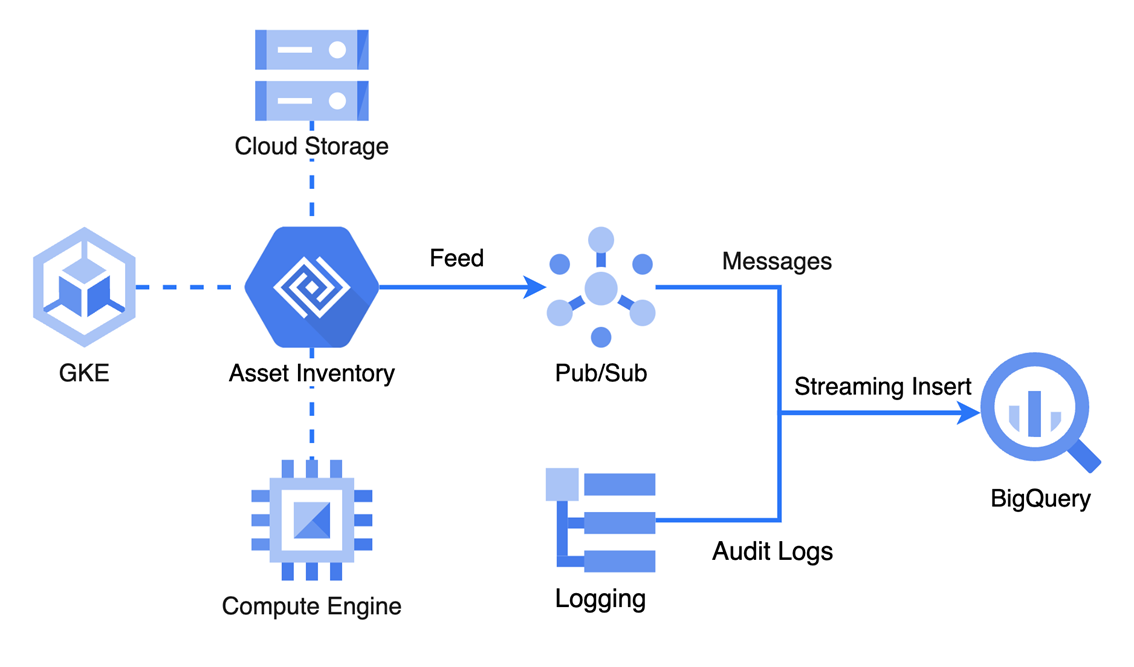
下面的步骤介绍如何配置这一数据实时流转和导出。加量的代码都是在 Terminal 或者 Cloud Shell执行的 Google Cloud SDK CLI 命令。
首先,将需要用到的 Asset Inventory, Pub/Sub, BigQuery 等服务在当前项目里打开。
创建一个 Pub/Sub Topic 来用于接收 Asset Inventory 的 Feed。
为 Asset Inventory 打开服务身份功能,这样会创建一个专用的服务账号,用于为 Asset Inventory 配置需要的权限来将数据写入其它服务,比如 Pub/Sub。
创建一个 Asset Inventory 的变更流 Feed,用于导出 GCE、GKE 和 GCS 的资源变更,写入到刚刚创建的 Pub/Sub 的 Topic。并在创建完后验证 Feed 创建成功。
创建一个新的 BigQuery 表,用于接收 Pub/Sub 转交的 Asset Inventory 的变更流。注意 Feed 数据的 Schema 比较复杂,而且可能会有变化。因此我们创建表时不为表设置与 Pub/Sub 消息格式一一对应的 Schema,而是给表一个 JSON 类型的 data 字段,用于接收消息的完整正文。
为 Pub/Sub对应的服务账号添加 IAM 角色,让其可以查看 BigQuery 的元数据,并往 BigQuery 里写数据。
为上面接收 Asset Inventory 变更流的 Pub/Sub 的 Topic 创建一个直接导出到 BigQuery 的 Subscription。这个 Subscription 会自动把所有的 Asset Inventory 通知消息实时并流式地插入到上面创建的 BigQuery 表中。
现在我们做一些 GCE 虚机相关的操作,比如创建一台虚机,然后删除它。这个操作可以在控制台或者命令行里执行,这里略过。
之后我们可以在 Pub/Sub 的监控中看到队列收到了通知消息。另外在 BigQuery 表中也可以看到新插入的数据。
我们可以用下面的查询,来列表虚机资源的状态变化。因为 data 列是 JSON 类型,可以比较方便地实用点操作符来引用相应的 JSON 字段。另外也可以将其转换成 STRING 或者 TIMESTAMP 类型来使用更多的函数操作。
SELECT
REGEXP_EXTRACT(STRING(data.asset.name), r'/([a-zA-Z0-9-_.]+$)') AS asset_name,
TIMESTAMP(STRING(data.asset.updateTime)) as update_time,
data.asset.resource.data.status as status,
data.asset.resource.data.fingerprint as fingerprint
FROM `youzhi-lab.youzhi_lab.asset-changes` ORDER BY update_time DESC LIMIT 1000
输出结果如下。
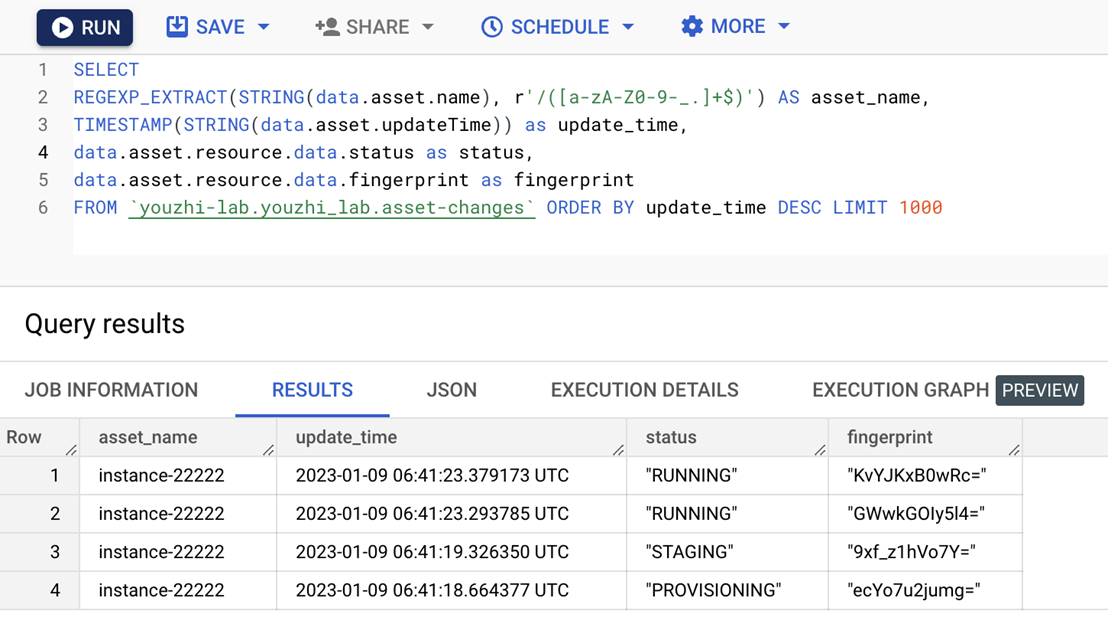
上面是针对资源变更通知信息这个单一数据做的简单分析。下面我们可结合 GCE 虚机操作的审计日志做综合分析。首先要配置审计日志导出到 BigQuery。在日志服务的路由规则里配置创建一个新的 Sink。
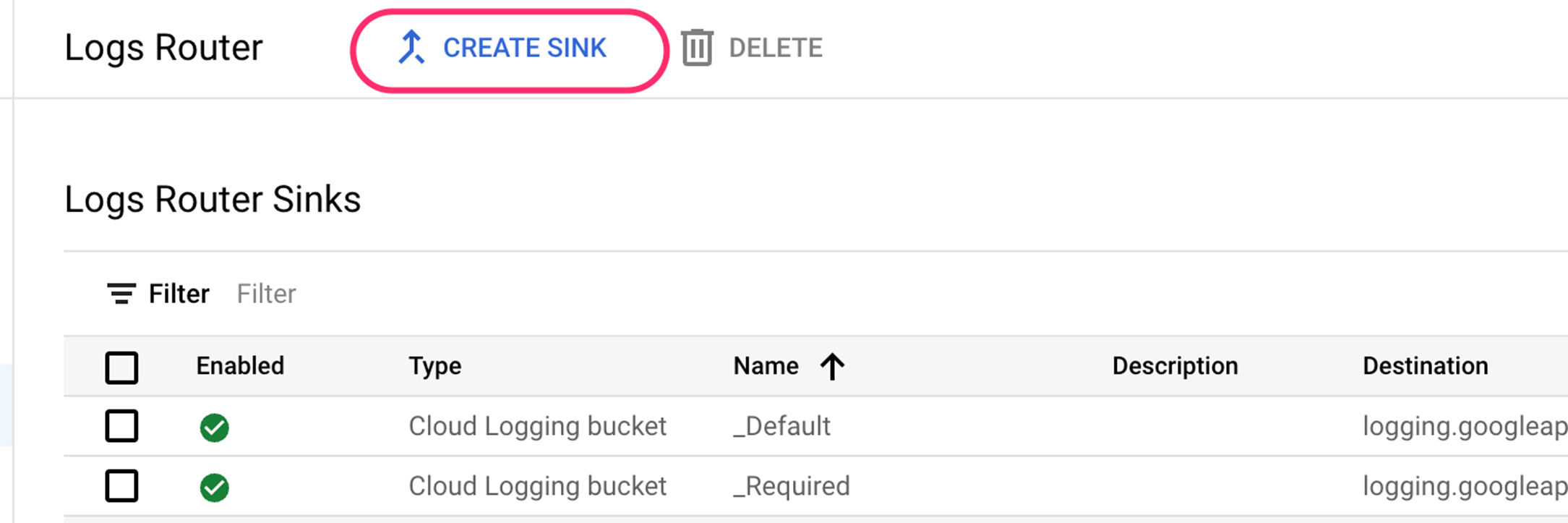
Sink 的配置如下所示。为了查询方便可以将目的表设置为与 Asset Inventory 消息表所在的同一个数据集下面。
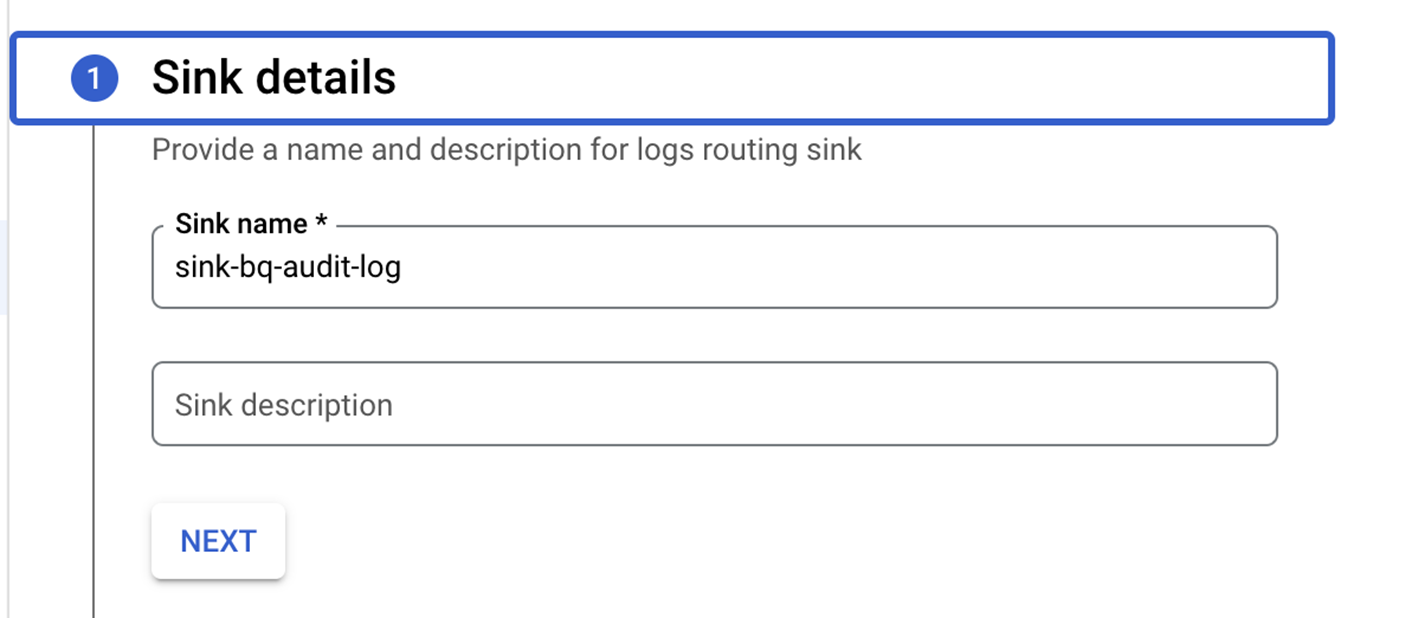
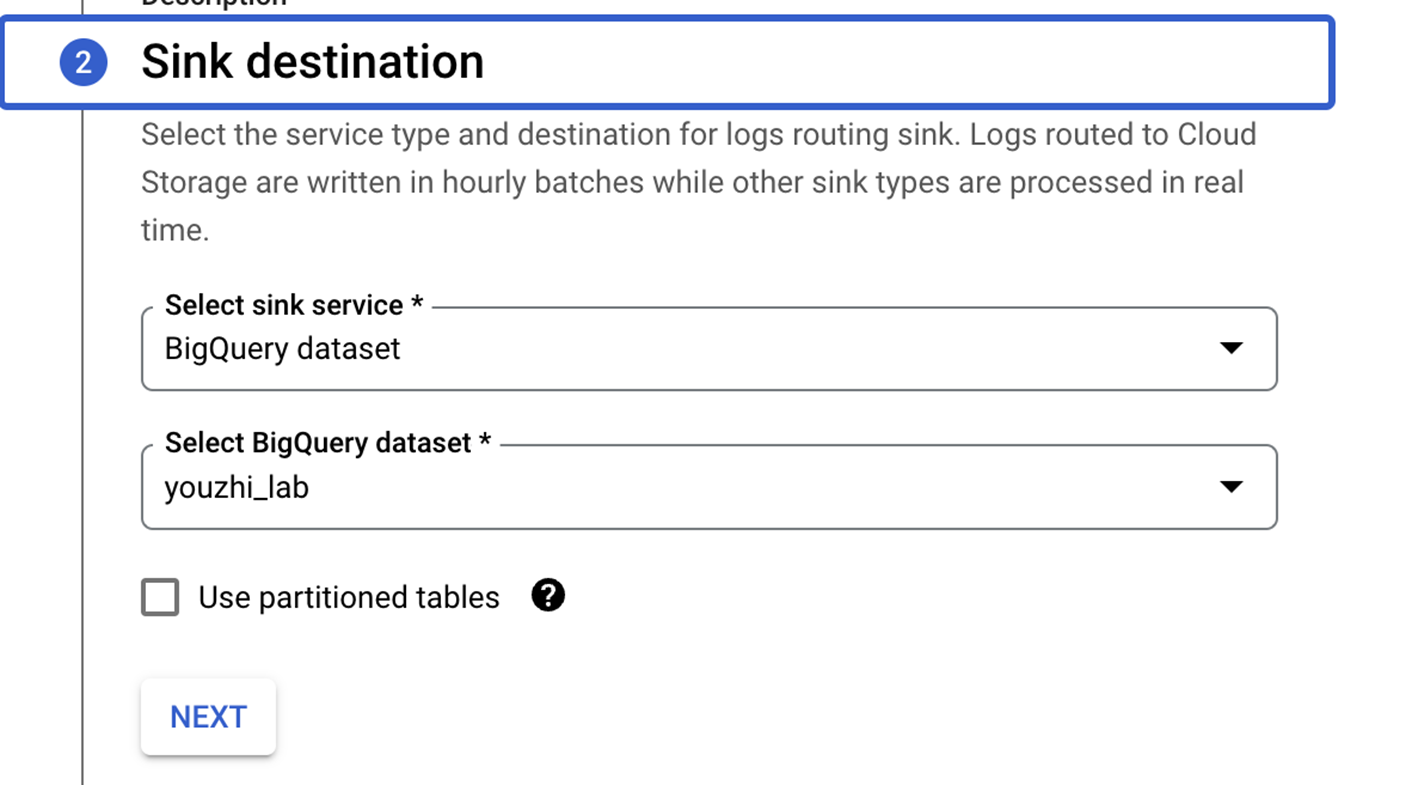
导出的日志项包含以下日志内容。

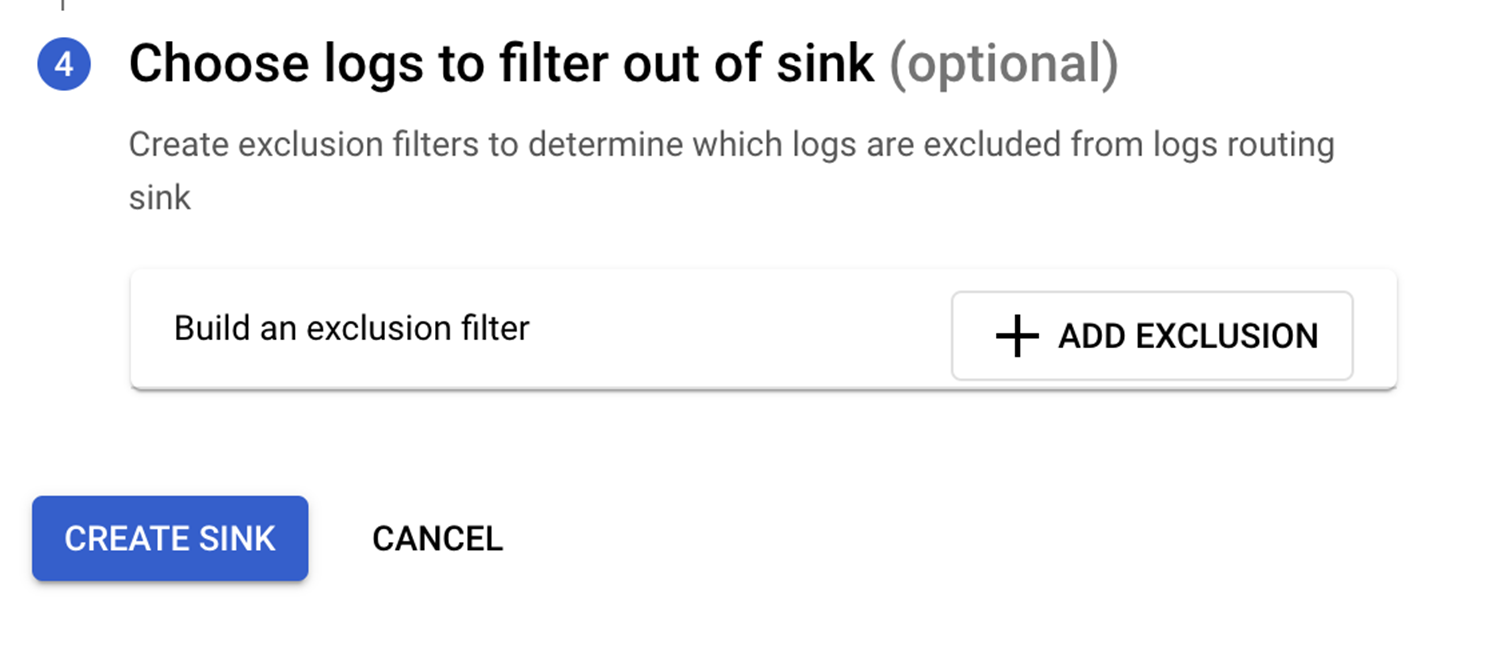
创建完成后,可以看到在指定数据集下面生成了一个审计日志表。这是一个按天拆分的表。
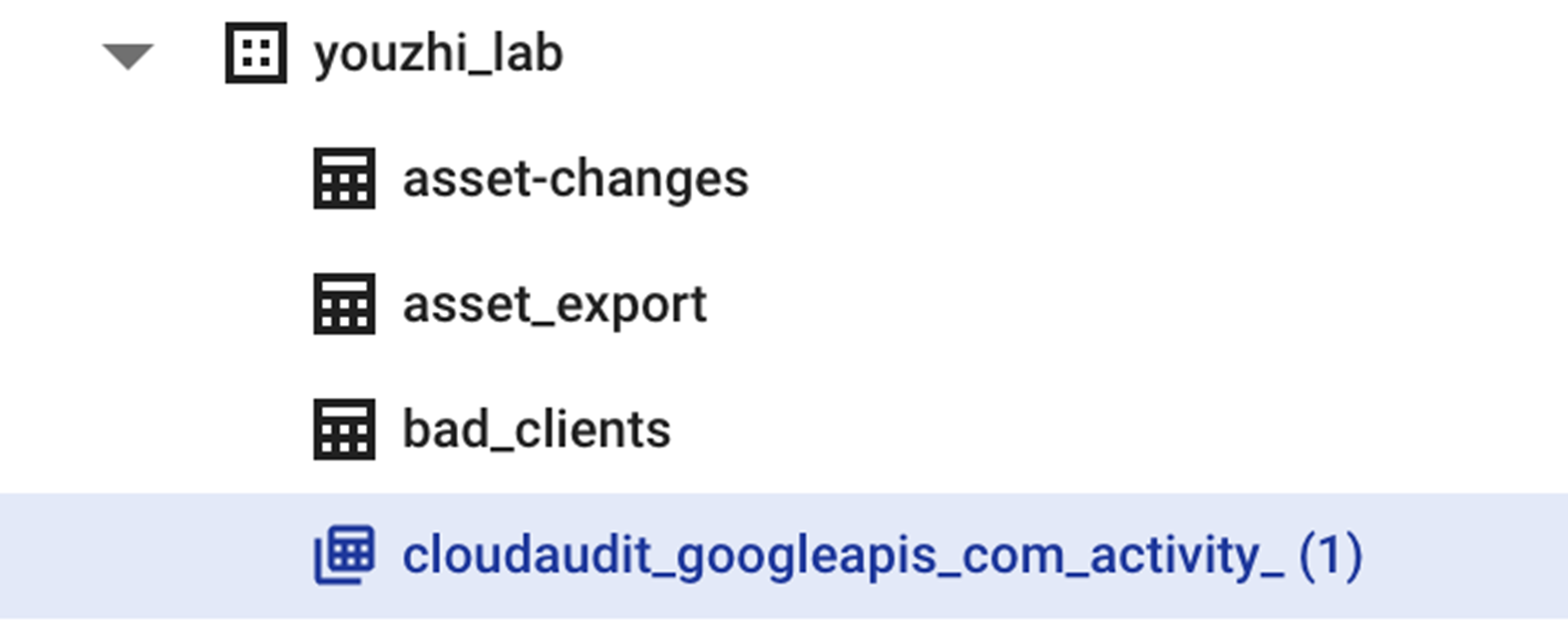
我们可以用下面的 SQL 命令关于某台虚机的操作日志以及资源变更日志,并按其时间戳进行排序,来分析资源变更与管理员操作的先后顺序和因果关系。WITH raw AS (
SELECT
REGEXP_EXTRACT(STRING(data.asset.name), r'/([a-zA-Z0-9-_.]+$)') AS asset_name,
TIMESTAMP(STRING(data.asset.updateTime)) AS update_time,
data.asset.resource.data.status AS status,
data.asset.resource.data.fingerprint AS fingerprint,
NULL AS principalEmail,
NULL AS methodName
FROM `youzhi-lab.youzhi_lab.asset-changes`
WHERE JSON_VALUE(data.asset.name) LIKE '%instance-44444'
UNION ALL
SELECT REGEXP_EXTRACT(t_audit.protopayload_auditlog.resourceName, r'/([a-zA-Z0-9-_.]+$)') AS asset_name,
t_audit.timestamp AS update_time,
NULL AS status,
NULL AS fingerprint,
t_audit.protopayload_auditlog.authenticationInfo.principalEmail AS principalEmail,
t_audit.protopayload_auditlog.methodName AS methodName
FROM `youzhi-lab.youzhi_lab.cloudaudit_googleapis_com_activity_*` AS t_audit
WHERE t_audit.protopayload_auditlog.resourceName LIKE '%instance-44444')
SELECT * FROM raw ORDER BY update_time
输出的结果如下

可以从结果里看到,虚机资源的 Provisioning, Staging, Running 等状态变化是在虚机创建的insert操作之后,而 Stopping 状态变更是在 delete 操作之后。同时我们也可以看到每个操作的执行人员账号。
附件
基于 Asset Inventory 的实时通知为新建资源创建标签的方案
Asset Inventory 中 GCE 资源变更消息含有的 JSON 字段列表
asset.ancestors[0]
asset.ancestors[1]
asset.assetType
asset.name
asset.resource.data.allocationAffinity.consumeAllocationType
asset.resource.data.canIpForward
asset.resource.data.confidentialInstanceConfig.enableConfidentialCompute
asset.resource.data.cpuPlatform
asset.resource.data.creationTimestamp
asset.resource.data.deletionProtection
asset.resource.data.description
asset.resource.data.disks[0].architecture
asset.resource.data.disks[0].autoDelete
asset.resource.data.disks[0].boot
asset.resource.data.disks[0].deviceName
asset.resource.data.disks[0].diskSizeGb
asset.resource.data.disks[0].guestOsFeatures[0].type
asset.resource.data.disks[0].guestOsFeatures[1].type
asset.resource.data.disks[0].guestOsFeatures[2].type
asset.resource.data.disks[0].index
asset.resource.data.disks[0].interface
asset.resource.data.disks[0].licenses[0]
asset.resource.data.disks[0].mode
asset.resource.data.disks[0].source
asset.resource.data.disks[0].type
asset.resource.data.displayDevice.enableDisplay
asset.resource.data.fingerprint
asset.resource.data.id
asset.resource.data.keyRevocationActionType
asset.resource.data.labelFingerprint
asset.resource.data.lastStartTimestamp
asset.resource.data.machineType
asset.resource.data.name
asset.resource.data.networkInterfaces[0].accessConfigs[0].name
asset.resource.data.networkInterfaces[0].accessConfigs[0].natIP
asset.resource.data.networkInterfaces[0].accessConfigs[0].networkTier
asset.resource.data.networkInterfaces[0].accessConfigs[0].type
asset.resource.data.networkInterfaces[0].fingerprint
asset.resource.data.networkInterfaces[0].name
asset.resource.data.networkInterfaces[0].network
asset.resource.data.networkInterfaces[0].networkIP
asset.resource.data.networkInterfaces[0].stackType
asset.resource.data.networkInterfaces[0].subnetwork
asset.resource.data.reservationAffinity.consumeReservationType
asset.resource.data.scheduling.automaticRestart
asset.resource.data.scheduling.onHostMaintenance
asset.resource.data.scheduling.preemptible
asset.resource.data.scheduling.provisioningModel
asset.resource.data.selfLink
asset.resource.data.serviceAccounts[0].email
asset.resource.data.serviceAccounts[0].scopes[0]
asset.resource.data.serviceAccounts[0].scopes[1]
asset.resource.data.serviceAccounts[0].scopes[2]
asset.resource.data.serviceAccounts[0].scopes[3]
asset.resource.data.serviceAccounts[0].scopes[4]
asset.resource.data.serviceAccounts[0].scopes[5]
asset.resource.data.shieldedInstanceConfig.enableIntegrityMonitoring
asset.resource.data.shieldedInstanceConfig.enableSecureBoot
asset.resource.data.shieldedInstanceConfig.enableVtpm
asset.resource.data.shieldedInstanceIntegrityPolicy.updateAutoLearnPolicy
asset.resource.data.startRestricted
asset.resource.data.status
asset.resource.data.tags.fingerprint
asset.resource.data.zone
asset.resource.discoveryDocumentUri
asset.resource.discoveryName
asset.resource.location
asset.resource.parent
asset.resource.version
asset.updateTime
priorAsset.ancestors[0]
priorAsset.ancestors[1]
priorAsset.assetType
priorAsset.name
priorAsset.resource.data.allocationAffinity.consumeAllocationType
priorAsset.resource.data.canIpForward
priorAsset.resource.data.confidentialInstanceConfig.enableConfidentialCompute
priorAsset.resource.data.cpuPlatform
priorAsset.resource.data.creationTimestamp
priorAsset.resource.data.deletionProtection
priorAsset.resource.data.description
priorAsset.resource.data.disks[0].architecture
priorAsset.resource.data.disks[0].autoDelete
priorAsset.resource.data.disks[0].boot
priorAsset.resource.data.disks[0].deviceName
priorAsset.resource.data.disks[0].diskSizeGb
priorAsset.resource.data.disks[0].guestOsFeatures[0].type
priorAsset.resource.data.disks[0].guestOsFeatures[1].type
priorAsset.resource.data.disks[0].guestOsFeatures[2].type
priorAsset.resource.data.disks[0].index
priorAsset.resource.data.disks[0].interface
priorAsset.resource.data.disks[0].licenses[0]
priorAsset.resource.data.disks[0].mode
priorAsset.resource.data.disks[0].source
priorAsset.resource.data.disks[0].type
priorAsset.resource.data.displayDevice.enableDisplay
priorAsset.resource.data.fingerprint
priorAsset.resource.data.id
priorAsset.resource.data.keyRevocationActionType
priorAsset.resource.data.labelFingerprint
priorAsset.resource.data.lastStartTimestamp
priorAsset.resource.data.machineType
priorAsset.resource.data.name
priorAsset.resource.data.networkInterfaces[0].accessConfigs[0].name
priorAsset.resource.data.networkInterfaces[0].accessConfigs[0].natIP
priorAsset.resource.data.networkInterfaces[0].accessConfigs[0].networkTier
priorAsset.resource.data.networkInterfaces[0].accessConfigs[0].type
priorAsset.resource.data.networkInterfaces[0].fingerprint
priorAsset.resource.data.networkInterfaces[0].name
priorAsset.resource.data.networkInterfaces[0].network
priorAsset.resource.data.networkInterfaces[0].networkIP
priorAsset.resource.data.networkInterfaces[0].stackType
priorAsset.resource.data.networkInterfaces[0].subnetwork
priorAsset.resource.data.reservationAffinity.consumeReservationType
priorAsset.resource.data.scheduling.automaticRestart
priorAsset.resource.data.scheduling.onHostMaintenance
priorAsset.resource.data.scheduling.preemptible
priorAsset.resource.data.scheduling.provisioningModel
priorAsset.resource.data.selfLink
priorAsset.resource.data.serviceAccounts[0].email
priorAsset.resource.data.serviceAccounts[0].scopes[0]
priorAsset.resource.data.serviceAccounts[0].scopes[1]
priorAsset.resource.data.serviceAccounts[0].scopes[2]
priorAsset.resource.data.serviceAccounts[0].scopes[3]
priorAsset.resource.data.serviceAccounts[0].scopes[4]
priorAsset.resource.data.serviceAccounts[0].scopes[5]
priorAsset.resource.data.shieldedInstanceConfig.enableIntegrityMonitoring
priorAsset.resource.data.shieldedInstanceConfig.enableSecureBoot
priorAsset.resource.data.shieldedInstanceConfig.enableVtpm
priorAsset.resource.data.shieldedInstanceIntegrityPolicy.updateAutoLearnPolicy
priorAsset.resource.data.startRestricted
priorAsset.resource.data.status
priorAsset.resource.data.tags.fingerprint
priorAsset.resource.data.zone
priorAsset.resource.discoveryDocumentUri
priorAsset.resource.discoveryName
priorAsset.resource.location
priorAsset.resource.parent
priorAsset.resource.version
priorAsset.updateTime
priorAssetState
window.startTime
文章信息
相关推荐
精选内容

微信公众号